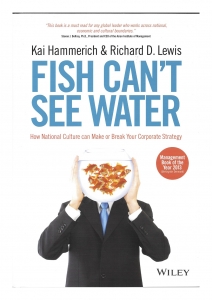The one sentence summary
Diversity of thinking and respect for other peoples’ perspectives are critical virtues for the leadership of global corporations.
WHAT THE BOOK SAYS 
- National culture can make or break your corporate strategy.
- Management and the board are often blind to their own culture – fish can’t see water. They may not spot derailing cultural dynamics in time to understand underperformance or even financial disaster.
- How these traits affect performance often depends on what stage the corporation has reached: traits good at launch could be poor ones later.
- Culture is the social programming of the mind that distinguishes the members of one category of people from another.
- The purpose of culture is to help the group survive and succeed. Culture is behaviour and behaviour is culture. Strategy and culture are intrinsically linked.
- Companies usually go through 5 lifecycle phases:
- Innovation – with the founders closely involved.
- Geographical expansion – the company meets the world for the first time.
- Product line expansion – they attempt to broaden their portfolio.
- Efficiency and scale – the industry matures, and so must the company.
- Consolidation – the endgame, with just a few global players remaining.
- National culture is at the core of virtually every organization, and this will affect its ability to execute strategy at each stage of the cycle. Management needs to pay careful attention to when the company is reaching a transformation point, because new attitudes may be needed.
WHAT’S GOOD ABOUT IT
- The book combines the classic Lewis model (see chart) with the Cultural Dynamic Model (see other chart).
- Work practices (how things get done) are underpinned by espoused values, usually nationally driven. The observed corporate culture eventually becomes embedded values, and employees all then naturally behave that way.
- Action you might wish to take as a result of this thinking:
- Determine the main dimensions of strategy and cultural alignment.
- Classify the company’s national type and its embedded values.
- Identify where the company is in the lifecycle.
- Establish how national culture may have enabled or derailed success at the most recent transformation point, and how it could affect the next one.
- Diagnose signs of potential crisis accentuated by any cultural dynamics.
WHAT YOU HAVE TO WATCH
- Not much. Just aim off for your own cultural characteristics: easier said than done.


